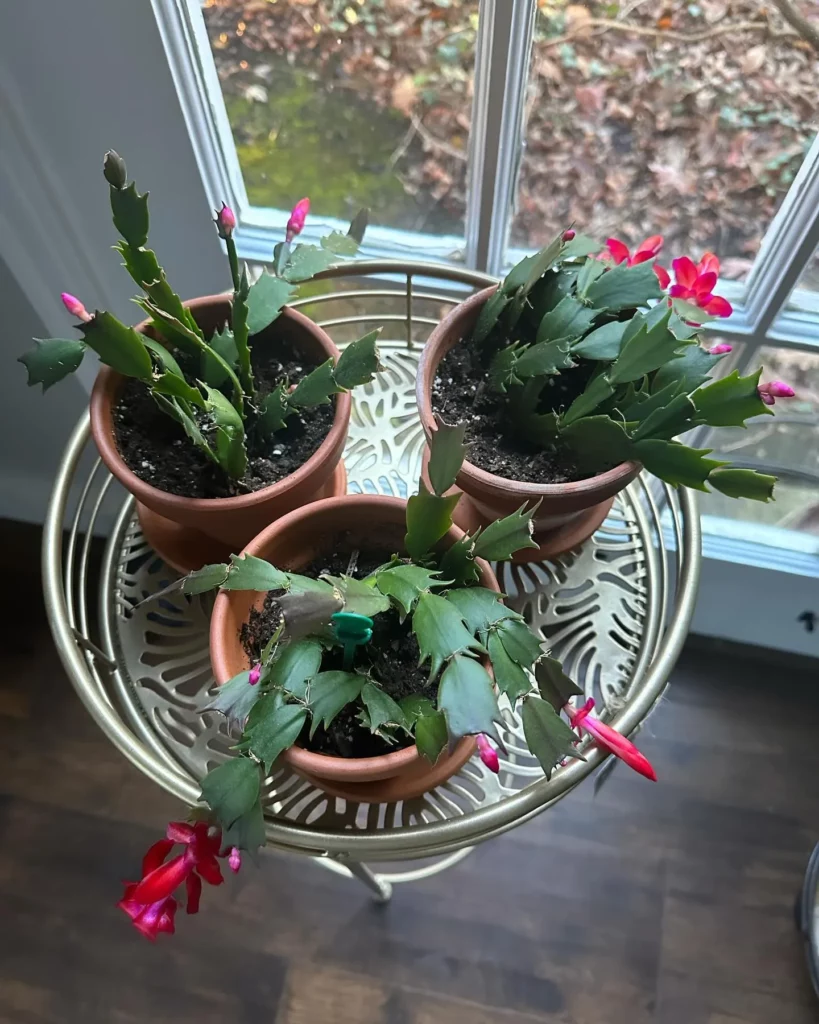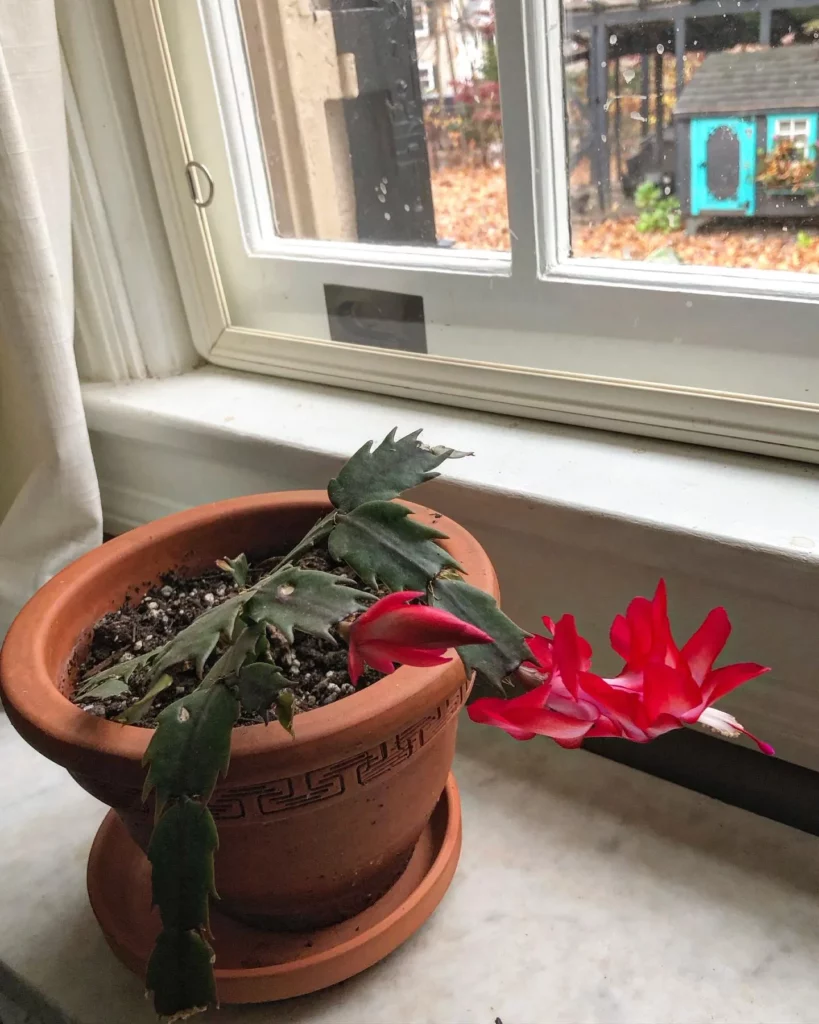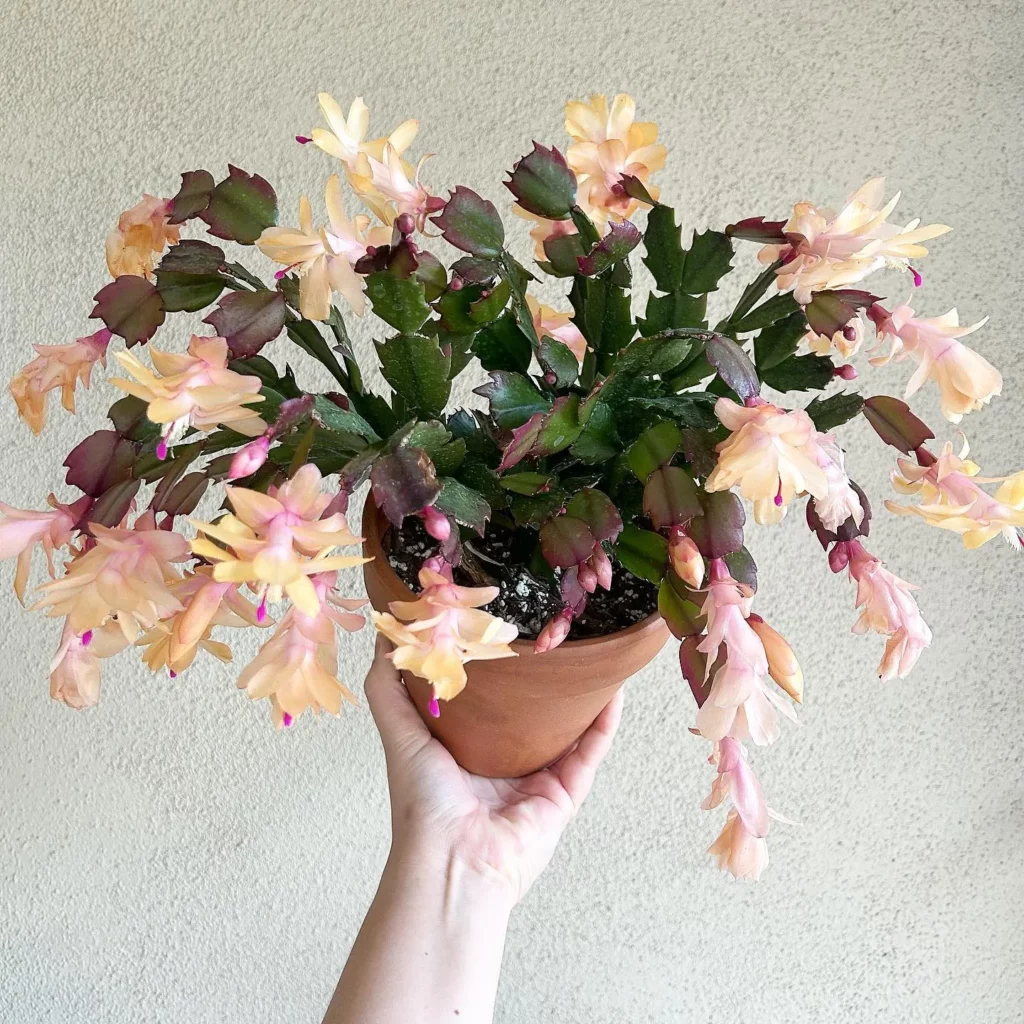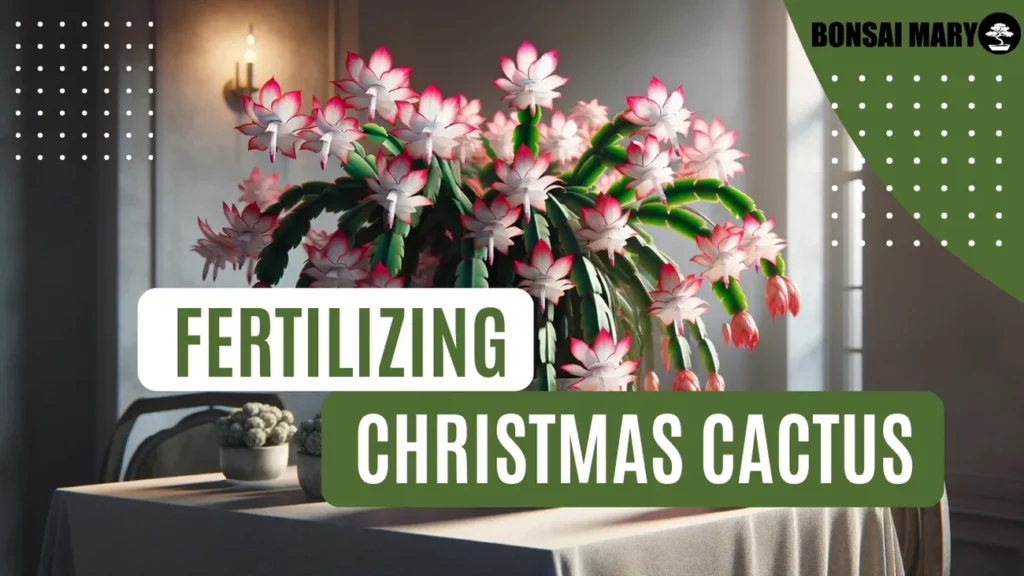To fertilize a Christmas Cactus for lush blooms, apply a half-strength balanced fertilizer every two weeks from late winter to late summer.
This guide offers vital tips for effectively fertilizing your Christmas cactus, a plant that can adorn your holiday season with its stunning blooms. It caters to both novice and experienced plant lovers, aiming to enhance your care routine by understanding the plant’s origins, growth habits, and specific nutrient needs for optimal health and flowering.
Understanding the Christmas Cactus

Before we delve into the essential tips for fertilizing your Christmas cactus, it’s crucial to first understand this unique plant and its specific care requirements.
The Christmas cactus, scientifically known as Schlumbergera, is a popular holiday plant known for its beautiful, vibrant blooms during the festive season. Native to the tropical rainforests of Brazil, these cacti have unique growth habits that set them apart from other cactus varieties.
Unlike desert cacti, Christmas cacti are epiphytic, meaning they naturally grow on trees rather than in the ground. This characteristic influences their care needs, particularly when it comes to watering and light exposure.
Growth Habit
The Christmas cactus has segmented flat stems that resemble leaves. These unique stems store water and nutrients, allowing the plant to withstand periods of drought. This built-in water reserve is why the Christmas cactus thrives in the humid rainforest environment.
During its dormant period, which typically occurs from late fall to early spring, the Christmas cactus requires less water and lower light levels. This period is essential to stimulate blooming in the following holiday season.
Care Requirements
To provide the best care for your Christmas cactus, consider the following:
- Light: Place your Christmas cactus in a bright location, but avoid direct sunlight, as it can scorch the leaves. Indirect or filtered light is ideal.
- Temperature: Maintain a temperature range of 60-70°F (15-21°C) during the active growing season. Cooler temperatures around 55°F (13°C) can help initiate blooming during the dormant period.
- Watering: Water your Christmas cactus when the top inch of the soil feels dry. Ensure proper drainage and avoid overwatering, as this can lead to root rot.
- Humidity: Increase humidity around your plant by placing a tray of water near it or using a humidifier, especially during the dry winter months.
No products found.
Choosing the Right Fertilizer

When it comes to caring for your Christmas cactus, selecting the right fertilizer is a crucial step towards ensuring its overall health and maximizing its blooming potential.
The key to choosing the perfect fertilizer lies in understanding the specific nutrients that your Christmas cactus needs. These nutrients play a vital role in promoting healthy growth and vibrant blooms.
Your Christmas cactus requires a balanced formula that provides essential macronutrients such as nitrogen (N), phosphorus (P), and potassium (K), along with trace minerals and micronutrients.
No products found.
To meet these requirements, look for a fertilizer specially formulated for flowering houseplants or cacti. It should have a balanced NPK ratio such as 10-10-10 or 20-20-20, which ensures a steady supply of nutrients without overfeeding your plant.
Additionally, opt for a fertilizer that includes beneficial trace minerals like iron, calcium, and magnesium.
If you prefer organic options, there are also natural fertilizers available that provide the necessary nutrients in a slow-release form. Look for organic fertilizers that are specifically designed for cacti or succulents.
When to Fertilize

Timing is crucial when it comes to fertilizing your Christmas cactus. To ensure optimal growth and vibrant blooms, it’s essential to follow a fertilizing schedule that aligns with the plant’s growth cycle.
Understanding the dormant period of your Christmas cactus is also important to avoid fertilization during this phase.
The growth cycle of a Christmas cactus typically consists of three main phases: the active growing phase, the budding phase, and the dormant phase. During the active growing phase, which usually occurs in spring and summer, your plant will benefit from regular fertilization as it actively puts out new growth.
However, as your Christmas cactus transitions into the budding phase, which typically occurs in late summer or early fall, it’s important to reduce or stop fertilization altogether.
This allows the plant to naturally prepare for blooming and ensures it isn’t overstimulated with excessive nutrients that may inhibit flower production.
The dormant period of your Christmas cactus usually occurs in late fall or early winter. During this time, the plant goes through a period of rest, and its growth slows down.
It’s crucial to avoid fertilizing during this phase as the plant’s nutrient requirements decrease significantly.
How to Fertilize a Christmas Cactus

Proper fertilization is crucial for the healthy growth and blooming of your Christmas cactus. By following the right techniques, such as using liquid fertilizers and incorporating fertilizer into your watering routine, you can ensure that your plant receives the nutrients it needs.
Here are some steps to help you fertilize your Christmas cactus effectively:
- Choose a high-quality liquid fertilizer specifically formulated for cacti and succulents. Look for a balanced formula that includes essential nutrients such as nitrogen, phosphorus, and potassium.
- Before applying the fertilizer, make sure the soil is moist. Water the plant lightly a day or two before fertilizing.
- Mix the liquid fertilizer according to the instructions on the label. Typically, you’ll dilute the fertilizer with water to achieve the desired concentration.
- Pour the diluted fertilizer evenly around the base of the plant, taking care not to overapply. Avoid getting the fertilizer on the leaves to prevent potential damage.
- After fertilizing, water the Christmas cactus as usual to help the nutrients penetrate the soil and reach the roots.
- Repeat the fertilization process every four to six weeks during the active growing season, which typically occurs from spring to fall. However, reduce the frequency during the winter months when the plant enters its dormant period.
Signs of Over-Fertilization

Over-fertilization can have detrimental effects on the health of your Christmas cactus. It’s important to understand the signs of excess nutrients and the potential negative impact they can have on your plant’s well-being.
If you notice any of the following indicators, it may be a sign that your Christmas cactus is experiencing over-fertilization:
- Yellowing or browning of leaves
- Wilting or drooping of stems
- Burned or brown edges on leaves
- Stunted growth or lack of new growth
- Root rot or fungal infections
When your Christmas cactus is over-fertilized, the excess nutrients can cause stress to the plant. This stress can weaken the overall health and resilience of the cactus, making it more susceptible to pests and diseases.
If you suspect that over-fertilization is the culprit behind your Christmas cactus’s symptoms, it’s crucial to take immediate action to rectify the situation. Here are some steps you can take to address over-fertilization:
- Stop fertilizing: Cease applying any fertilizers to your Christmas cactus until the issue is resolved.
- Flush the soil: Water your plant thoroughly to flush out excess nutrients from the soil. Allow the water to drain completely.
- Adjust watering frequency: After flushing the soil, adjust your watering schedule to ensure the plant is receiving the appropriate amount of moisture without further adding to nutrient buildup.
- Monitor soil moisture: Regularly check the moisture levels in the soil to prevent overwatering, which could exacerbate the issue.
- Reevaluate fertilizer application: Once the plant has recovered and balanced its nutrient levels, reassess your fertilizing routine. Ensure you’re using the correct type of fertilizer and following proper application guidelines.
Troubleshooting Nutrient Deficiencies

Nutrient deficiencies in your Christmas cactus can manifest in various ways, such as yellowing leaves or stunted growth. It’s important to identify these common deficiencies and address them promptly through nutrient supplementation to ensure the overall health and vitality of your plant.
Identifying Nutrient Deficiencies
Yellowing leaves or foliage that appears pale and sickly are common signs of nutrient deficiencies in your Christmas cactus. Different deficiencies can cause specific symptoms, so it’s crucial to identify the specific issue affecting your plant.
Here are some common nutrient deficiencies and their associated symptoms:
- Potassium deficiency: Yellowing and browning of leaf edges, weak stems
- Nitrogen deficiency: Pale or yellow leaves, slow growth
- Phosphorus deficiency: Dark green leaves, stunted growth
- Magnesium deficiency: Yellowing between the veins of older leaves, leaf drop
Addressing Nutrient Deficiencies
Once you have identified a nutrient deficiency in your Christmas cactus, you can take steps to address it. One effective method is to provide a nutrient-rich fertilizer specifically formulated for your plant’s needs.
Look for a balanced fertilizer that contains the necessary nutrients, such as potassium, nitrogen, phosphorus, and magnesium.
Follow the instructions on the fertilizer package to determine the appropriate application rate and frequency. Be careful not to overuse the fertilizer, as this can lead to other issues.
Regularly monitor your plant’s progress, and adjust the fertilizer application as needed.
In addition to fertilizer, ensure your Christmas cactus receives adequate light exposure and proper watering. Adequate light helps the plant utilize the available nutrients, while proper watering ensures efficient nutrient uptake.
Additional Care Tips for Blooming Success

While fertilizing plays a crucial role in the health and blooming potential of your Christmas cactus, there are other factors to consider for optimal plant care. Paying attention to environmental conditions, temperature, humidity, and light exposure can significantly impact the growth and blooming of your Christmas cactus.
To create an ideal environment for your Christmas cactus, aim for temperatures between 60-70°F (15-21°C) during the day and slightly lower temperatures at night. Avoid exposing your plant to extreme temperature fluctuations as it can lead to stress.
Proper humidity levels are also essential for your Christmas cactus. Indoor environments tend to be drier, especially during the winter months when heaters are running.
To increase humidity, you can use a humidifier or place a tray filled with water near your plant. Avoid placing the tray directly underneath the pot to prevent waterlogged roots.
One of the most critical factors for the blooming success of your Christmas cactus is light exposure. These plants thrive in bright, indirect light.
Place your Christmas cactus near a window with filtered sunlight or provide it with artificial light if natural sunlight is limited. Avoid exposing your plant to direct sunlight, as it can cause sunburn and damage the leaves.
Conclusion
To ensure your Christmas cactus thrives and produces lush blooms, proper fertilizing is essential. By following the tips outlined in this article, you can provide your plant with the nutrients it needs for healthy growth and vibrant flowers.
Remember to choose a balanced fertilizer that contains the necessary nutrients for your Christmas cactus. Timing is also crucial, so be sure to fertilize during the appropriate periods of the plant’s growth cycle, avoiding fertilization during its dormant phase.
When applying fertilizer, use the recommended methods such as incorporating it into your watering routine or opting for liquid fertilizers.
Pay attention to signs of over-fertilization and nutrient deficiencies, making adjustments as needed to maintain optimal plant health.
In addition to fertilizing, don’t forget to provide your Christmas cactus with proper care, including the right environmental conditions, temperature, humidity, and light exposure. With consistent care and attention, you can enjoy vibrant blooms year after year and keep your Christmas cactus thriving.
FAQ
Q: Can I fertilize my Christmas cactus to promote lush blooms?
A: Absolutely! Fertilizing your Christmas cactus is essential for vibrant blooms. Follow our tips for the best results.
Q: How can I understand the unique characteristics of the Christmas cactus?
A: Understanding the Christmas cactus is key to successful plant care. Learn about its origins, growth habits, and care requirements in our detailed guide.
Q: What type of fertilizer should I choose for my Christmas cactus?
A: Choosing the right fertilizer with balanced nutrients is crucial. Discover the key nutrients your plant needs and the best type of fertilizer to nourish it.
Q: When is the ideal time to fertilize my Christmas cactus?
A: Timing is important. Learn about the ideal fertilizing schedule based on your plant’s growth cycle and when to avoid fertilizing during its dormant period.
Q: How should I apply fertilizer to my Christmas cactus?
A: Proper application techniques are essential for optimal results. Explore different methods such as liquid fertilizers and incorporating fertilizer into watering routines.
Q: What are the signs of over-fertilization in my Christmas cactus?
A: Over-fertilization can harm your plant. Learn to recognize the signs of excess nutrients, understand the negative effects, and how to rectify the situation.
Q: How can I troubleshoot nutrient deficiencies in my Christmas cactus?
A: Nutrient deficiencies can affect your plant’s health. Find out how to identify common deficiencies and supplement your Christmas cactus with the right nutrients.
Q: Are there any additional care tips for blooming success?
A: Absolutely! Learn about optimal environmental conditions, temperature, humidity, and light exposure to ensure your Christmas cactus achieves its full bloom potential.
Q: How do I ensure consistent care for my Christmas cactus?
A: Consistent care and attention are crucial. Review our Christmas cactus fertilizing tips and other care guidelines to enjoy vibrant blooms year after year.





